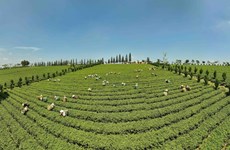Measures to strengthen blue dragon export
The price of dragon fruit in the central province of Binh Thuan ,
the country's largest blue dragon fruit cultivation area, has recently
fallen significantly, the Communist Party of Vietnam Online Newspaper
reported on August 20.
The price of dragon fruit in the central province of Binh Thuan ,
the country's largest blue dragon fruit cultivation area, has recently
fallen significantly, the Communist Party of Vietnam Online Newspaper
reported on August 20.
Over the past time, the blue dragon cultivation area has increased rapidly in our country’s provinces and cities. Some countries and territories also started growing the fruit. So Vietnam ’s blue dragon will have to compete fiercely with the same kind of fruit grown in the regional countries.
Moreover, the quality of fruit is also challenged by some diseases, leading to reduce export value in the coming time when foreign markets require strict standards.
To export Vietnam ’s blue dragon with high value, it has to overcome barriers about food safety and plant quarantine. These are two strict requirements from demanding customers. We have to meet requirements for food safety. For example, if importers detect residues exceeding permitted level, they will destroy or return the fruit.
Each country has a different quarantine requirement for the import and export of fresh consumable commodities which we have to meet. For US market, for example, we have to follow strict rules issued by the Animal and Plant Health Inspection Service (APHIS). All shipments imported to the country must go through irradiation treatment to ensure decontamination. The Japanese and the Republic of Korea ’s markets, require that the products have to be treated with hot steam technology to eradicate pests and insects. These are the technical barriers that Vietnamese exporters have to navigate.
In Vietnam , a disease known as brown spot appeared in 2010, a fungus that thrives on flowers and fruits and is very difficult to prevent with no identified fungicide being significantly effective. The disease usually appears in rainy season with about a 20-30 percent chance of the entire country’s crop at risk from acquiring the disease and with a clear visible presence immediately disqualifying the fruit from the export market.
By the end of 2013 there were 3,566 hectares affected in just three provinces; Binh Thuan province with 1,266 hectares, Tien Giang with 1,500 hectares and Long An with 800 hectares, causing considerable losses to the producers.
The Plant Protection Department (PPD) warned farmers not abuse pesticides in disease prevention; instead, farmers should use methods of cultivation, care, irrigation and fertilization for the blue dragon as wisely as possible and to use the method of bundling to limit injury by insects and diseases. More importantly, it must produce blue dragon to VietGAP standards. Binh Thuan province has planned to cultivate 7,300 hectares of the fruit under the VietGAP mode.
Tien Giang and Long An provinces are also developing VietGAP production models. Although the scale is small, the farmers are clearly aware of disease prevention problems and the need to ensure quality for food safety, a prerequisite for export.
To meet the stringent market and country requirements on food safety and plant quarantine, farmers must produce in a sustainable manner to the VietGAP standard. Partners in the value chain will become more willing to promote and sell the fruit on the international market, providing better returns for the producers.-VNA
Over the past time, the blue dragon cultivation area has increased rapidly in our country’s provinces and cities. Some countries and territories also started growing the fruit. So Vietnam ’s blue dragon will have to compete fiercely with the same kind of fruit grown in the regional countries.
Moreover, the quality of fruit is also challenged by some diseases, leading to reduce export value in the coming time when foreign markets require strict standards.
To export Vietnam ’s blue dragon with high value, it has to overcome barriers about food safety and plant quarantine. These are two strict requirements from demanding customers. We have to meet requirements for food safety. For example, if importers detect residues exceeding permitted level, they will destroy or return the fruit.
Each country has a different quarantine requirement for the import and export of fresh consumable commodities which we have to meet. For US market, for example, we have to follow strict rules issued by the Animal and Plant Health Inspection Service (APHIS). All shipments imported to the country must go through irradiation treatment to ensure decontamination. The Japanese and the Republic of Korea ’s markets, require that the products have to be treated with hot steam technology to eradicate pests and insects. These are the technical barriers that Vietnamese exporters have to navigate.
In Vietnam , a disease known as brown spot appeared in 2010, a fungus that thrives on flowers and fruits and is very difficult to prevent with no identified fungicide being significantly effective. The disease usually appears in rainy season with about a 20-30 percent chance of the entire country’s crop at risk from acquiring the disease and with a clear visible presence immediately disqualifying the fruit from the export market.
By the end of 2013 there were 3,566 hectares affected in just three provinces; Binh Thuan province with 1,266 hectares, Tien Giang with 1,500 hectares and Long An with 800 hectares, causing considerable losses to the producers.
The Plant Protection Department (PPD) warned farmers not abuse pesticides in disease prevention; instead, farmers should use methods of cultivation, care, irrigation and fertilization for the blue dragon as wisely as possible and to use the method of bundling to limit injury by insects and diseases. More importantly, it must produce blue dragon to VietGAP standards. Binh Thuan province has planned to cultivate 7,300 hectares of the fruit under the VietGAP mode.
Tien Giang and Long An provinces are also developing VietGAP production models. Although the scale is small, the farmers are clearly aware of disease prevention problems and the need to ensure quality for food safety, a prerequisite for export.
To meet the stringent market and country requirements on food safety and plant quarantine, farmers must produce in a sustainable manner to the VietGAP standard. Partners in the value chain will become more willing to promote and sell the fruit on the international market, providing better returns for the producers.-VNA












